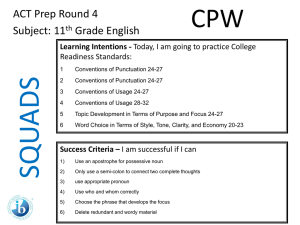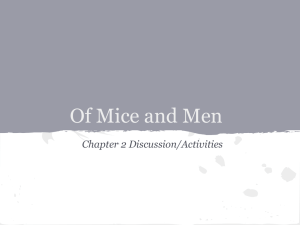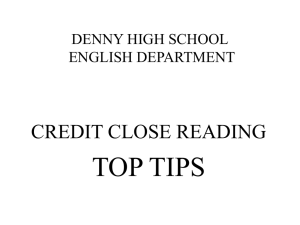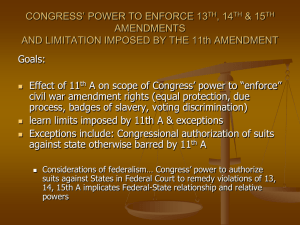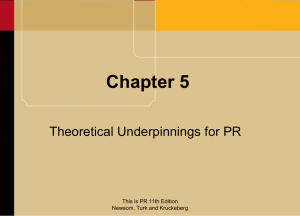11th Grade Reading PPT
advertisement
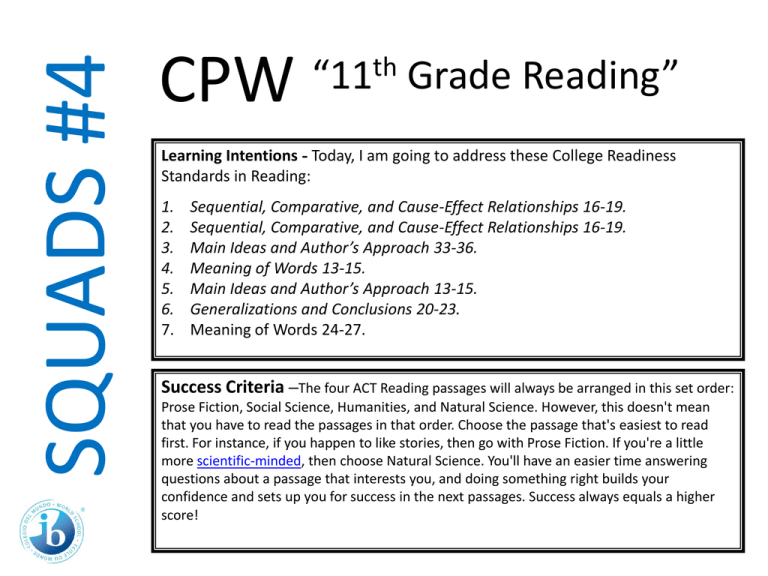
SQUADS #4 CPW “11th Grade Reading” Learning Intentions - Today, I am going to address these College Readiness Standards in Reading: 1. 2. 3. 4. 5. 6. 7. Sequential, Comparative, and Cause-Effect Relationships 16-19. Sequential, Comparative, and Cause-Effect Relationships 16-19. Main Ideas and Author’s Approach 33-36. Meaning of Words 13-15. Main Ideas and Author’s Approach 13-15. Generalizations and Conclusions 20-23. Meaning of Words 24-27. Success Criteria –The four ACT Reading passages will always be arranged in this set order: Prose Fiction, Social Science, Humanities, and Natural Science. However, this doesn't mean 1. that you have to read the passages in that order. Choose the passage that's easiest to read first. For instance, if you happen to like stories, then go with Prose Fiction. If you're a little 2. more scientific-minded, then choose Natural Science. You'll have an easier time answering questions about a passage that interests you, and doing something right builds your confidence and sets up you for success in the next passages. Success always equals a higher score! Quick Note! • Today’s questions are based on the printed passage you will receive shortly. After reading your passage individually or as a group, choose the best answer to each question. You may refer to the passages as often as necessary. • You have 4 Minutes to read your passage! 11th Grade Reading #1. The passage indicates that at the time Frank and Sigwarth presented new evidence supporting the small-comet theory, Frank most nearly felt: A. relieved but bitter about how he had been treated. B. grateful that ridicule of his work would end. C. proud that he had been proved right. D. satisfied and filled with anticipation of glory. 11th Grade Reading #2. According to the passage, the research that led to the development of the small-comet theory began with a project originally intended to study: A. the electrical activity accompanying sunspots. B. water entering Earth’s upper atmosphere. C. static in satellite transmissions. D. specks in satellite images. 11th Grade Reading #3. The main function of lines 64–66 in terms of the eighth paragraph (lines 59–66) as a whole is to: A. give a sense of proportion to the numbers provided earlier in the paragraph. B. point out the limitations of the evidence provided by the Iowa scientists. C. supplement the paragraph’s description of the comets with additional details about their size and capacity. D. provide readers with a sense of how old the planet really is. 11th Grade Reading #4. When Richard Zare says that scientists lead a “constant schizophrenic existence” (lines 34–35), he most nearly means that they: A. often suffer psychologically from the demands of their work. B. tend to be either complete cynics or people who believe too much. C. are often guilty of either doing nothing or of fooling themselves. D. have to maintain a balance between accepting and challenging ideas. 11th Grade Reading #5. The article ends with a definite statement, “Had he been a researcher of lesser standing, his theory probably would have died long ago”. What is the main idea of this line? A. Had Frank toned down his claims about small-comets, he would have been a hero. B. Had Frank been more popular, his ideas and theories would have been even better. C. If Frank didn’t have the reputation he did, his theories wouldn’t be here today. D. Frank was a very unpopular and sad scientist with no original ideas or theories. 11th Grade Reading #6. As defined in this passage, what is the “small-comet theory”? A. The Earth projects small comets of UV light into space that has a horrible polluting effect on space. B. The Earth is being hit by thousands of small comets that are invisible to the human eye. C. There currently are small comets hitting Earth right now. D. The Earth is being bombarded by hundreds of housesized comets day after day that rain water on our planet and are the reason we have oceans. 11th Grade Reading #7. As used in line 79, the phrase “unbeknown to most” most clearly represents… A. Everyone knows B. Only some know C. No one knows D. A and C CPW 11th Grade Reading • Exchange your answer sheet with that of another squad… • Launch the PDF.
